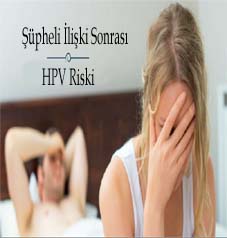My Spouse Has HPV !

When men are diagnosed with HPV infections, their female partners should immediately get an HPV DNA test. Treatment and follow-up protocols should be determined based on the test results. If the test shows no HPV a low-risk HPV type, they should be vaccinated immediately, and the couple should be protected using condoms until the completion of the infected partner’s treatment. If the test shows a high-risk HPV type, colposcopy should be performed; and if required, the patient should be protected from uterine cancer with preventive measures such as biopsy and strict follow-up protocols.
In cases where women are diagnosed with HPV infections, it is controversial whether HPV DNA testing is necessary for male partners. Vaccination of men is still under discussion. However, it is known that vaccination of men between 9 and 26 years of age prevents viral transmission and protects against penile cancer, head and neck cancer, and canal cancer.
Presence of HPV in one of the spouses causes them to question their relationship. It should be known that HPV is mostly transmitted sexually. Due to its long incubation period and long-term retention in the body, the virus may have already entered the body before the couples’ sexual intercourse. The man may have been infected by the virus before his current relationship and may have transmitted it to his current partner/wife. In women, the first infection may not cause noticeable symptoms, because they sometimes progress quite mildly, and the current lesion may be the recurrence of the first infection.
The subject of non-sexual transmission of genital HPV is controversial. Most studies conducted on sexually inexperienced young women (Andersson-Ellström et al., 1994; Dillner et al., 1999) have shown that non-sexual transmission of HPV is a rare but possible phenomenon. However, a number of studies have reported that HPV can also occasionally be transmitted through other means besides sexual activity. Possible non-sexual means include vertical transmission, fomites, and skin contact (Pao et al., 1992; Cason et al., 1995; Winer et al., 2003, Mindel and Tideman, 1999; Frega et al. 2003). It can also be rarely transmitted through the use of epilating wax. Wax carries the risk of transmitting the virus from the living skin cells, in which the virus has settled, to the irritated skin area of another person during the next waxing process.
Couples should be aware of these possibilities before blaming each other.
This article may also interest you

We recommend that you have an HPV DNA test 1 week after intercourse to see if a suspected relationship is transmitted.
Read more

 TR
TR SQ
SQ